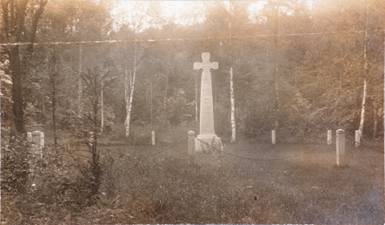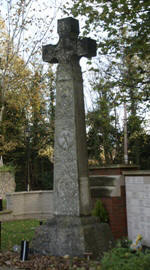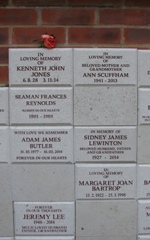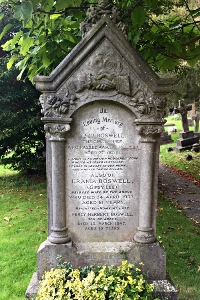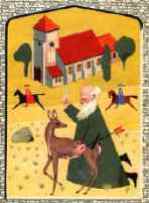

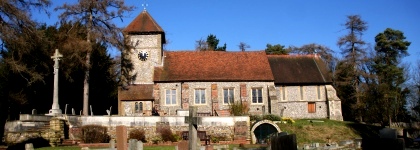
St. GILES CHURCHYARD
We do not publish the full graveyard map. For grave location queries please contact the Parish Office in the first instance.
From the earliest times, the Churchyard was part of the Rector's Freehold, but he or she cannot sell any part of it. In past times Rectors of Farnborough would have received fees connected to use of the Churchyard. Now, all fees are paid to the Parochial Church Council.
 |
| Google Map View, Click for an interactive enlargement |
People pay a fee to be buried in the Churchyard but cannot buy a grave space as is possible in a public cemetery. However tombstones remain the property of the family who install them. The permission of the Rector is required before a monument is put in place, and it must comply with the regulations of the Diocese, which are set down by the Diocesan Chancellor.
Until the 18th century, there were no tombstones in the Churchyard. The ground was re-used time and time again, resulting in the level gradually rising, as can be seen by comparing it with the level of the paths.
The Yew Tree was at the North West corner of the Churchyard when it was planted in 1643. From the mid-1700s, tombstones came into use, and by 1854 the Churchyard was full of Memorial Stones, making re-use of the ground impossible.
Extra ground, 0.4 acres, was therefore purchased round the north and west sides of the original graveyard, which sufficed until the first part of what we now call the 'new' graveyard was opened in 1885 after Farnborough became an independant parish.
The ‘Lower Gate’, we can place with some certainty. It was at the bottom of the slope next to the roadside wall leading from the road along the south side of the church, and ‘The Hole’, which was the chalk pit partially filled in 1909, and now the car park. We must remember that at this time the road would have been more or less on a level with the churchyard as the lowering of the carriageway did not occur until 1833, and thus the entire churchyard would require fencing.
The ‘Church Gate’ (not called a Lych Gate) was some fifty feet nearer the church than the present one. If we use measurements guided by the position of the grave stones pre 1749 and excluding those after 1885, when we know that the churchyard was enlarged, we establish a very small area round the church, but one which is in agreement with the figure quoted in the Tithe Assessment of 1840 of 1 Rood and 15 Square Poles ( 0.35 Acres).
|
|
|
| The view from Church Road | The Skeggs Tomb |
The 'Church Gate’, was in a position now occupied by the Skeggs Tomb, behind the small hedge, to the left after entering the Churchyard through the present Lych Gate. This is a good example of a table tomb which, although it has lost its original railings, would have been similar to those retained by two other examples near the church door. The present Lych Gate was erected in 1902 as a memorial to Rachel Fox.
The Churchyard contains good examples of tomb stones showing how tastes have changed over the centuries, and some examples are marked on the plan. The oldest stone dated 1725 is an elaborate set of the body stone type, with Head and Foot stones, and is situated by the fir tree to the West side of the path leading to Church Field. The Wynne Stone, made of local rag stone, near the Choir Vestry is more typical of the age, as are the slightly more elaborate examples to the South of the Clergy Vestry, hiding behind the table tomb, to the Rance Family.
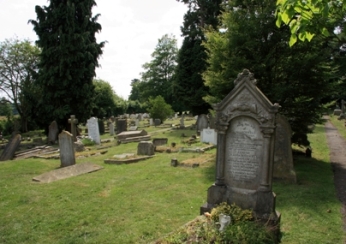 |
|
The Evans/Butterworth tomb in the western part of the Victorian extension is a good example of an ‘Architectural’ memorial, while the March Bronze of the ‘Fallen Angel’ illustrates the fine work of this talented local family who supplied the bronze figures for the Canadian National War Memorial in Ottawa.
The Lubbock Cross, which stands just beyond the Garden of Remembrance, is well worth close inspection. The symbols carved on it, Bronze Age Axes, The Avebury Stone Circle and even a Bee Skep, commemorate the many activities in which the family excelled.
PARISH HISTORY
Gypsy Lee Funeral & Grave
In the Victorian Extension there are many graves of members of the traveller community, including the famous ‘Gipsy Lee’ , whose real name was Urania Boswell. She died in 1933. The grave is the resting place of four members of the Boswell family in total.
YouTube video of the procession.
She was the last Gipsy
Queen in the area and
lived for the later part of her life in Willow Walk, Locksbottom.
Lichens in the Churchyard
The churchyard at Farnborough , like so many surrounding our parish churches, is a place of peace, history and remembrance. This special atmosphere owes much to the wildlife that makes the churchyard its home.The plants, birds and insects are most noticeable but there is another group which is easily overlooked and yet by adorning the memorials in shades of yellow, white and grey make a huge contribution to the atmosphere of the graveyard. These are lichens, the endurance specialists of the plant world although strictly speaking they are not plants but a union of simple algae or bacteria capable of producing sugars by photosynthesis which are sheltered within the growing tissue of a fungus which provides the structure that we see as a lichen. Each benefits from the other – a true symbiosis of life.
A church and its graveyard provide undisturbed substrates on which lichens can grow especially on stone. Remarkably, about one third of the approximately 2000 species of lichen which occur in Britain and Ireland are found in churchyards.
A recent survey at St Giles found nearly 70 species of lichen. Perhaps the best place to appreciate the variety and beauty of these is on the south side of the church where the oldest memorials are to be found. Most obvious are the yellow orbicular patches of Caloplaca flavescens on the limestone memorials. Stop and look more closely at these and the beautiful orange jam tart-like fruiting bodies can be seen in the centre. Another limestone headstone is covered in the half-moon shaped outlines of one of the grey Caloplacas, C. teicholyta.
The more acidic sandstone headstones have a completely different lichen assemblage, the most notable being the vivid yellow-green powdery lichen with an impossible name – Psilolechia lucida. There is no other lichen in the south-east which is quite like this, so if you can get your tongue around the name, you can impress your friends with your knowledge!
Lichen colonisation is a natural consequence of any surface that is left exposed to the environment for a long time. Lichens indicate clean air and are regarded by many as decorative rather than disfiguring. Lichens are very sensitive to environmental change and our lichen flora is constantly under threat from numerous human activities. Without lichens we would have a much poorer understanding of the health of our environment for humans as well as for wildlife.
Ishpi Blatchley British Lichen Society June 2019
